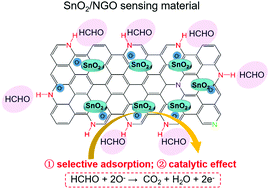High content of hydrogenated pyridinic-N in a SnO2/NGO heterogeneous material as an ultra-high sensitivity formaldehyde sensor†
Abstract
Developing ultrasensitive materials with high selectivity and low detection limit has always been a challenge in the gas sensor field. In this work, SnO2/N-doped graphene oxide (NGO) heterogeneous materials are prepared by a facile hydrothermal method. The different N-doped moieties in NGO play a very important role in regulating the microstructure and sensing properties of the composite. The results show that SnO2/NGO with a high content of hydrogenated pyridinic-N exhibits excellent sensing performances towards formaldehyde. It shows good response linearity in the concentration range of 100–1000 ppb and 1–10 ppm. The actual detection limit is reduced to 100 ppb, and the response time and recovery time are 46 s and 63 s. The material shows high selectivity to formaldehyde, and the anti-interference coefficients are 8.6, 11.3, and 11.2 for ethanol, ammonia and acetone, respectively. The high selectivity and sensitivity of SnO2/NGO are attributed to the following aspects: (i) large specific surface area and strong adsorption ability; (ii) selective adsorption originated from different activated regions of hydrogenated pyridinic-N; (iii) catalytic effect on redox reactions between HCHO and O− by the hydrogenated pyridinic-N structure; (iv) uniformly distributed heterojunctions facilitate carrier separation and transport.



 Please wait while we load your content...
Please wait while we load your content...